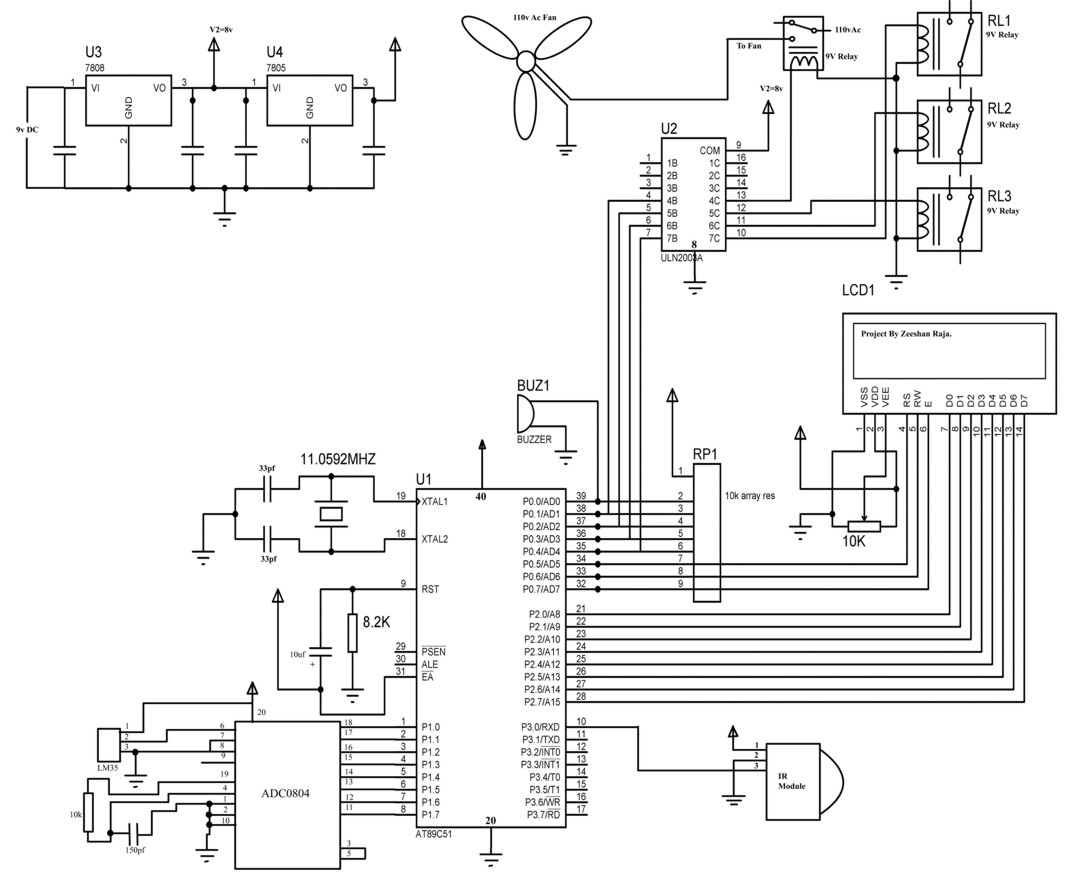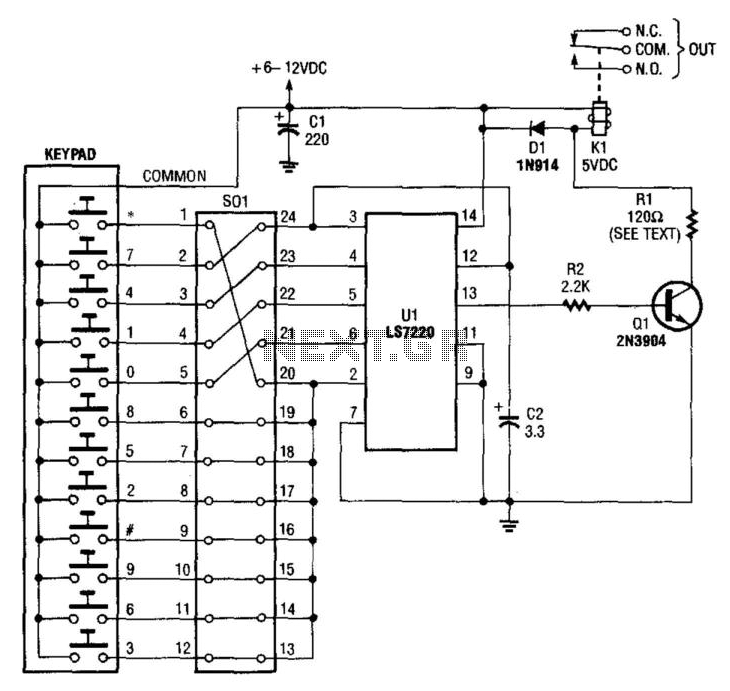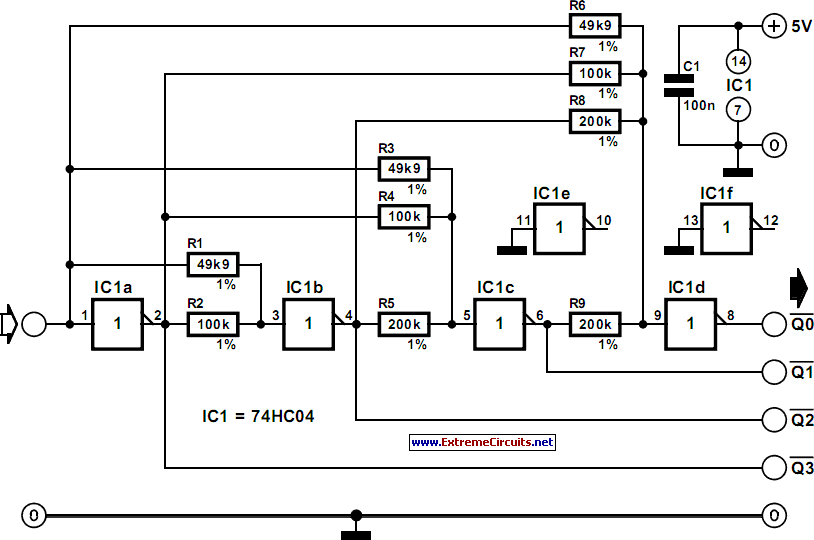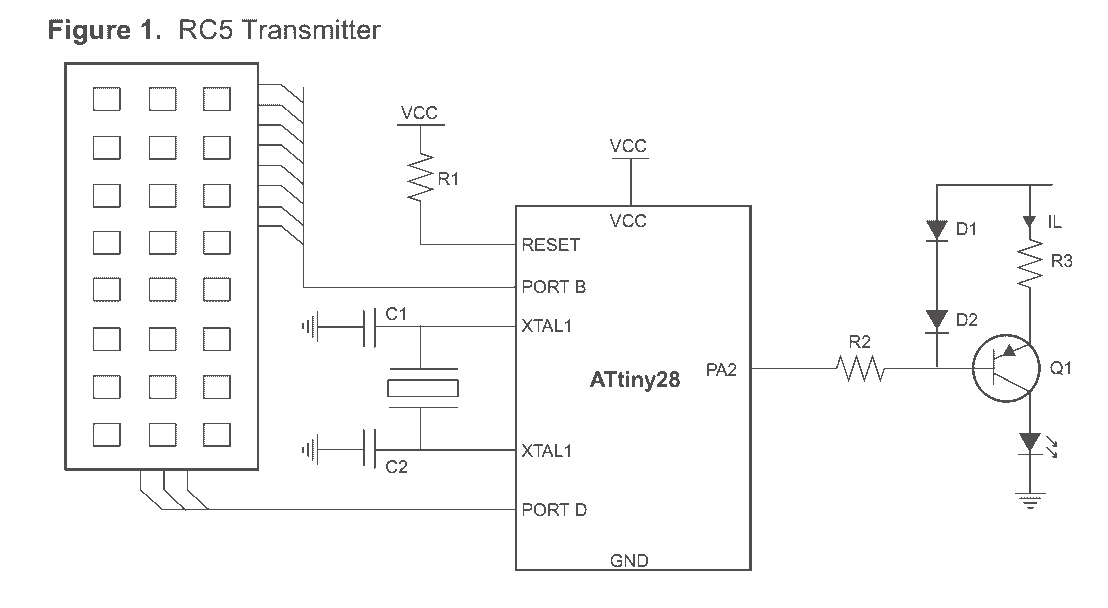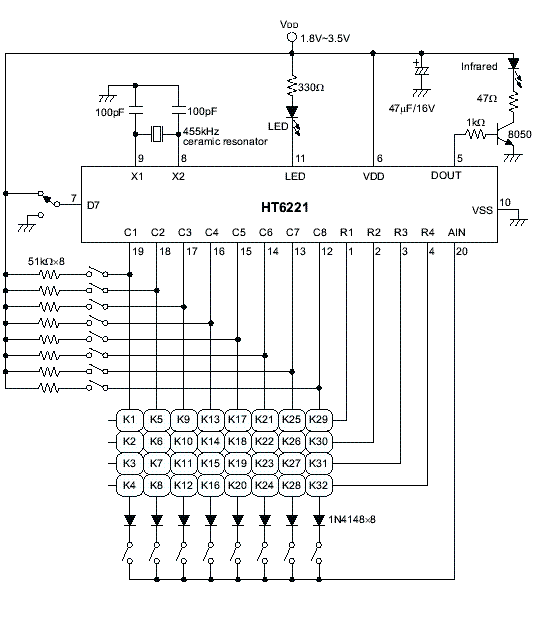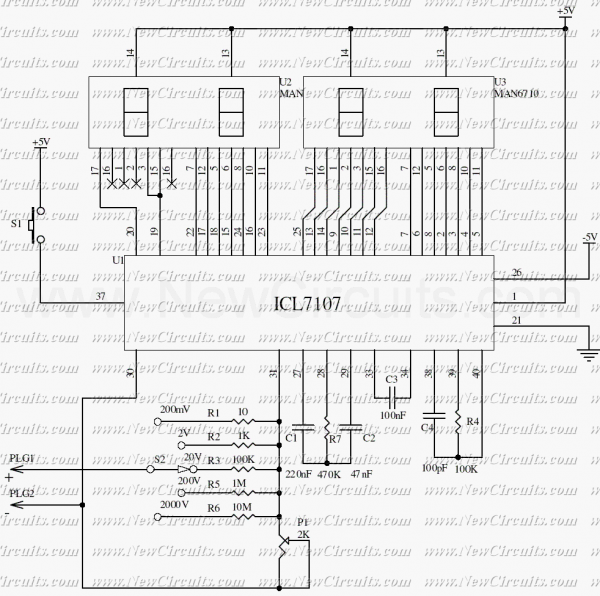
Digital Remote Thermometers
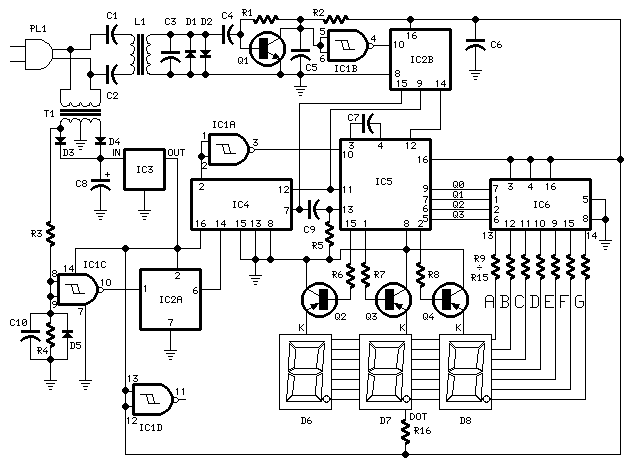
This circuit is designed for accurate centigrade temperature measurement. It features a transmitter section that converts the sensor's output voltage, which is proportional to the measured temperature, into a frequency signal. The output frequency bursts are transmitted through the mains supply cables. The receiver section counts these bursts from the mains supply and displays the count on three 7-segment LED displays. The least significant digit indicates tenths of a degree, allowing for a temperature range of 0.0 to 99.9 °C. IC1 serves as a precision centigrade temperature sensor with a linear output of 10 mV/°C, which drives IC2, a voltage-to-frequency converter. At its output pin (3), an input of 10 mV is converted into 100 Hz frequency pulses. For instance, a temperature of 20 °C results in IC1 producing 200 mV, which IC2 then converts to 2 kHz. Q1 acts as the driver for the power output transistor Q2, which is coupled to the mains supply through inductor L1 and capacitors C7 and C8. The frequency pulses from the mains supply are safely insulated by capacitors C1, C2, and inductor L1, and are amplified by Q1, with diodes D1 and D2 limiting input peaks. The pulses are filtered by capacitor C5, squared by IC1B, divided by 10 in IC2B, and sent to the clock input of IC5 for final counting. IC4 functions as the time-base generator, providing reset pulses for IC1B and IC5, and enabling latches and gate time for IC5 at a frequency of 1 Hz. This is driven by a 5 Hz square wave derived from the 50 Hz mains frequency picked up from the secondary of transformer T1, squared by IC1C, and divided by 10 in IC2A. IC5 controls the cathodes of the displays via transistors Q2, Q3, and Q4 at a multiplexing rate determined by capacitor C7. It also drives the parallel anodes of the three displays through the BCD-to-7 segment decoder IC6.
This circuit utilizes several integrated circuits (ICs) and discrete components to achieve precise temperature measurement and display. The key component, IC1, is a temperature sensor that provides a linear voltage output corresponding to the temperature. The voltage output is then fed into IC2, which is critical for converting this voltage into frequency, enabling the system to transmit temperature data over the mains supply.
The design incorporates safety features, including the use of capacitors and inductors to isolate the high-voltage mains from sensitive components, ensuring that the circuit can operate safely in a domestic environment. The use of multiplexing for the 7-segment displays allows for efficient use of the display resources while providing clear and precise temperature readings.
The time-base generator, IC4, plays a vital role in synchronizing the counting process, ensuring that the system operates accurately over time. The division of the mains frequency to generate a stable time base allows for consistent counting and display updates. The overall architecture of the circuit is well-structured, allowing for easy integration into various applications requiring temperature monitoring and display.This circuit is intended for precision centigrade temperature measurement, with a transmitter section converting to frequency the sensor`s output voltage proportional to the measured temperature. The output frequency bursts are conveyed into the mains supply cables. The receiver section counts the bursts coming from mains supply and shows the counting on three 7-segment LED displays.
The least significant digit displays tenths of degree and then a 00. 0 to 99. 9 °C range is obtained. IC1 is a precision centigrade temperature sensor with a linear output of 10mV/ °C driving IC2, a voltage-frequency converter. At its output pin (3), an input of 10mV is converted to 100Hz frequency pulses. Thus, for example, a temperature of 20 °C is converted by IC1 to 200mV and then by IC2 to 2KHz. Q1 is the driver of the power output transistor Q2, coupled to the mains supply by L1 and C7, C8. The frequency pulses coming from mains supply and safely insulated by C1, C2 & L1 are amplified by Q1; diodes D1, D2 limiting peaks at its input.
Pulses are filtered by C5, squared by IC1B, divided by 10 in IC2B and sent for the final count at the clock input of IC5. IC4 is the time-base generator: it provides reset pulses for IC1B and IC5 and enables latches and gate-time of IC5 at 1Hz frequency.
It is driven by a 5Hz square wave obtained from 50Hz mains frequency picked-up from T1 secondary, squared by IC1C and divided by 10 in IC2A. IC5 drives the displays` cathodes via Q2, Q3 & Q4 at a multiplexing rate frequency fixed by C7. It drives also the 3 displays` paralleled anodes via the BCD-to-7 segment decoder IC6. 🔗 External reference
This circuit utilizes several integrated circuits (ICs) and discrete components to achieve precise temperature measurement and display. The key component, IC1, is a temperature sensor that provides a linear voltage output corresponding to the temperature. The voltage output is then fed into IC2, which is critical for converting this voltage into frequency, enabling the system to transmit temperature data over the mains supply.
The design incorporates safety features, including the use of capacitors and inductors to isolate the high-voltage mains from sensitive components, ensuring that the circuit can operate safely in a domestic environment. The use of multiplexing for the 7-segment displays allows for efficient use of the display resources while providing clear and precise temperature readings.
The time-base generator, IC4, plays a vital role in synchronizing the counting process, ensuring that the system operates accurately over time. The division of the mains frequency to generate a stable time base allows for consistent counting and display updates. The overall architecture of the circuit is well-structured, allowing for easy integration into various applications requiring temperature monitoring and display.This circuit is intended for precision centigrade temperature measurement, with a transmitter section converting to frequency the sensor`s output voltage proportional to the measured temperature. The output frequency bursts are conveyed into the mains supply cables. The receiver section counts the bursts coming from mains supply and shows the counting on three 7-segment LED displays.
The least significant digit displays tenths of degree and then a 00. 0 to 99. 9 °C range is obtained. IC1 is a precision centigrade temperature sensor with a linear output of 10mV/ °C driving IC2, a voltage-frequency converter. At its output pin (3), an input of 10mV is converted to 100Hz frequency pulses. Thus, for example, a temperature of 20 °C is converted by IC1 to 200mV and then by IC2 to 2KHz. Q1 is the driver of the power output transistor Q2, coupled to the mains supply by L1 and C7, C8. The frequency pulses coming from mains supply and safely insulated by C1, C2 & L1 are amplified by Q1; diodes D1, D2 limiting peaks at its input.
Pulses are filtered by C5, squared by IC1B, divided by 10 in IC2B and sent for the final count at the clock input of IC5. IC4 is the time-base generator: it provides reset pulses for IC1B and IC5 and enables latches and gate-time of IC5 at 1Hz frequency.
It is driven by a 5Hz square wave obtained from 50Hz mains frequency picked-up from T1 secondary, squared by IC1C and divided by 10 in IC2A. IC5 drives the displays` cathodes via Q2, Q3 & Q4 at a multiplexing rate frequency fixed by C7. It drives also the 3 displays` paralleled anodes via the BCD-to-7 segment decoder IC6. 🔗 External reference
Warning: include(partials/cookie-banner.php): Failed to open stream: Permission denied in /var/www/html/nextgr/view-circuit.php on line 713
Warning: include(): Failed opening 'partials/cookie-banner.php' for inclusion (include_path='.:/usr/share/php') in /var/www/html/nextgr/view-circuit.php on line 713
